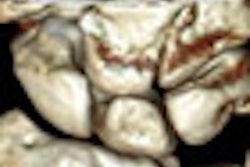Researchers at the University of California, Davis (UCD) have created an MRI technique that captures movement of the wrist by combining a series of brief MRI scans.
The technique, called "active MRI" and detailed online December 31 in PLOS One, acquires one image every half second, delivering a series of images in approximately 30 seconds. Conventional MRI can take as long as three minutes to acquire one image set and is not fast enough to create moving images, according to the researchers.
Lead author Dr. Robert Boutin, professor of radiology at UCD, in a press release described active MRI as a "live-action movie" that can be slowed, stopped, or reversed as needed. The technique could be useful in diagnosing subtle changes in physiology that indicate the onset of conditions such as wrist instability.
With conventional MRI, movement of the bones in the wrist area can interfere with a scanner's magnetic field, creating signal drop-offs and other artifacts. The resulting dark bands can obscure the moving wrist. To overcome this problem, the researchers used dielectric pads, which stabilize the magnetic field and shift artifacts away from the area of interest and to the side, allowing doctors to see the wrist bones.
For the current study, Boutin and colleagues used a 3-tesla active-MRI protocol on 15 wrists of 10 subjects with no symptoms of wrist problems. Participants' wrists were imaged as they performed motions such as clenching their fist, rotating their wrist, and waving the hand side to side. Each exam lasted 10 minutes.
Next, the researchers plan to validate the technology by using it on patients with symptoms of wrist instability, said co-author Abhijit Chaudhari, PhD. They also plan to investigate gender differences in musculoskeletal conditions, including why women tend to be more susceptible to hand osteoarthritis and carpal tunnel syndrome.


.fFmgij6Hin.png?auto=compress%2Cformat&fit=crop&h=100&q=70&w=100)





.fFmgij6Hin.png?auto=compress%2Cformat&fit=crop&h=167&q=70&w=250)











